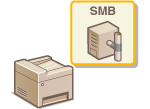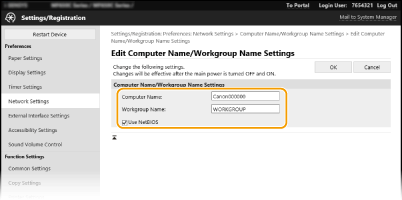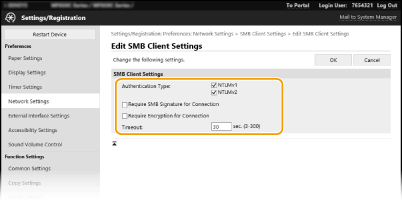Configuring SMB
 | Server Message Block (SMB) is a protocol for sharing resources, such as files and printers, with more than one device in a network. The machine uses SMB to store scanned documents into a shared folder. Depending on your network, you may have to set the computer name and workgroup name. |
 |
For more information about the basic operations to be performed when setting the machine from the Remote UI, see Setting Up Menu Options from Remote UI. |
Configuring the Computer Name and Workgroup Name
Specify the name of the machine on the network and the name of the workgroup it belongs to. If your environment does not have workgroups, create a workgroup in Windows and enter the name of that workgroup.
1
Start the Remote UI and log in to System Manager Mode. Starting Remote UI
2
Click [Settings/Registration] on the Portal page. Remote UI Screen
3
Select [Network Settings]  [Computer Name/Workgroup Name Settings].
[Computer Name/Workgroup Name Settings].
 [Computer Name/Workgroup Name Settings].
[Computer Name/Workgroup Name Settings].4
Click [Edit].
5
Specify the required settings.

[Computer Name]
Enter alphanumeric characters for the name of the machine on the network.
Enter alphanumeric characters for the name of the machine on the network.
[Workgroup Name]
Workgroup name is a name for grouping multiple computers so that basic network functions, such as file sharing, become available in a Windows network. Enter alphanumeric characters for the name of the workgroup that the machine belongs to.
Workgroup name is a name for grouping multiple computers so that basic network functions, such as file sharing, become available in a Windows network. Enter alphanumeric characters for the name of the workgroup that the machine belongs to.
[Use NetBIOS]
Select the check box when using NetBIOS.
Select the check box when using NetBIOS.

Computer names or workgroup names that start with an asterisk (*) cannot be registered to a WINS server.
6
Click [OK].
7
Restart the machine. Restarting the Machine
Configuring the SMB Client
Specify the settings to use when the machine connects to a network as an SMB client.
1
Start the Remote UI and log in to System Manager Mode. Starting Remote UI
2
Click [Settings/Registration] on the Portal page. Remote UI Screen
3
Select [Network Settings]  [SMB Client Settings].
[SMB Client Settings].
 [SMB Client Settings].
[SMB Client Settings].4
Click [Edit].
5
Specify the required settings.

[Authentication Type]
Select the authentication protocol version. Select either [NTLMv1] or [NTLMv2], according to the destination SMB server. You can also select both.
Select the authentication protocol version. Select either [NTLMv1] or [NTLMv2], according to the destination SMB server. You can also select both.
[Require SMB Signature for Connection]
Select the check box to request an SMB packet signature when connecting to an SMB server.
Select the check box to request an SMB packet signature when connecting to an SMB server.
[Require Encryption for Connection]
Select the check box to request a connection with SMB v3.0 encrypted communication when connecting to an SMB server.
Select the check box to request a connection with SMB v3.0 encrypted communication when connecting to an SMB server.
[Timeout]
Set the time until the SMB connection destination responds.
Set the time until the SMB connection destination responds.
When sending to an SMB server, the network connection was lost or the response on the server side was slow, causing a wait time timeout on the machine side before the data could be sent or forwarding could be completed. If this happens, you may be able to avoid a timeout by increasing the wait time.
6
Click [OK].
Specify the Version of SMB Client
Specify the version of SMB to use with the SMB client.
1
Start the Remote UI and log in to System Manager Mode. Starting Remote UI
2
Click [Settings/Registration] on the Portal page. Remote UI Screen
3
Select [Network Settings]  [Specified SMB Client Versions].
[Specified SMB Client Versions].
 [Specified SMB Client Versions].
[Specified SMB Client Versions].4
Click [Edit].
5
Select the check box for the version of SMB to use with the SMB client.
6
Click [OK].
 |
If you select the [Require Encryption for Connection] check box, the machine can only connect to SMB servers that support SMB v3.0 encrypted communication. When the [1.0] and [2.0] check box is selected for [Specified SMB Client Versions] but [3.0] check box is not selected, the machine cannot connect to SMB servers that do not support SMB v3.0 encrypted communication. Use the same version of SMB with the SMB server and SMB client. SMB cannot be used if the versions differ. |